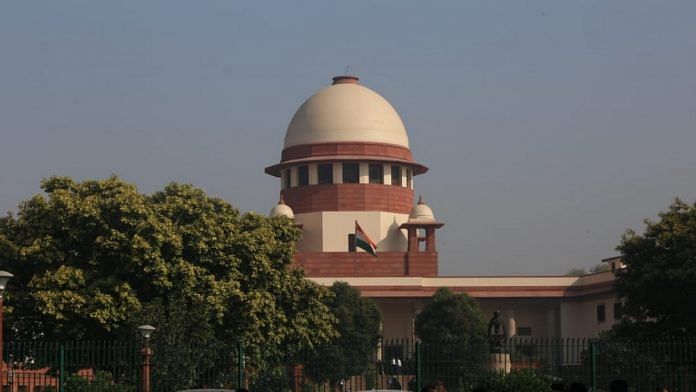
New Delhi: On Monday, a nine-judge bench of the Supreme Court began its hearing on the larger questions on faith and fundamental rights referred to it by a bench that was dealing with review petitions in the Sabarimala case.
The nine-judge bench is headed by Chief Justice S.A. Bobde and comprises Justices Banumathi, Ashok Bhushan, L. Nageshwara Rao, M.M. Shantanagoudar, S.A. Nazeer, R.S. Reddy, B.R. Gavai and Suryakant.
The setting up of a nine-judge bench is not ordinary. This is only the 16th nine-judge bench in the Supreme Court’s 70-year history, making all these judgments landmark verdicts on the questions decided by them.
Here are five landmark verdicts delivered by previous nine-judge benches.
Right to privacy
The most recent case heard by a nine-judge bench was in 2017 — the Justice K.S. Puttaswamy (Retd) v. Union of India. The bench unanimously held that right to privacy was a fundamental right protected under the Constitution of India.
The ruling was an outcome of a petition challenging the constitutional validity of the government’s Aadhaar scheme. The question was referred to a nine-judge bench after Mukul Rohatgi, the then attorney general, told the court in 2015 that there was no constitutionally-guaranteed right to privacy.
The judgment was a landmark in constitutional jurisprudence, and has since helped the Supreme Court in reading down Section 377 of the IPC to decriminalise consensual same sex relations, and in striking down Section 497, which made adultery a crime.
Also read: SC 9-judge bench on Sabarimala to now hear larger issues of faith vs fundamental rights
SR Bommai case
S.R. Bommai was the chief minister of Karnataka. In the 1994 judgment, the Supreme Court had set aside then Karnataka Governor P. Venkatasubbaiah’s decision to deny Bommai a chance to prove his majority on the floor of the House.
The court held that the President’s power to dismiss a state government is not absolute and that the dissolution of the legislative assembly should happen only where it is necessary.
It also laid down guidelines for imposition of President’s rule under Article 356 of the Constitution.
The case has since become one of the most-cited in petitions whenever a situation of a hung assembly has come up.
Judicial appointments cases
The present system of judicial appointments, through a collegium, can be attributed to three different cases known as ‘three judges cases’ — two of which were nine-judge bench decisions.
The first was SP Gupta v. Union of India in 1981, in which a seven-judge bench held that in case of a disagreement between the executive and the judiciary in appointment of judges, the “ultimate power” would be with the central government.
This was followed by two nine-judge bench decisions — Supreme Court Advocates-on-Record Association v. Union of India (second judges case) in 1993, and In re Special Reference 1 of 1998 (third judges case).
In the second case, the bench overruled the judgement in the SP Gupta case, holding that the chief justice’s opinion enjoys supremacy over the executive in matter of judges’ appointments.
It is in this case that the court added checks and balances in appointments, laying down the need for a “collegium” of judges.
In the third case, the nine-judge bench delivered a unanimous ruling and set up the collegium system as we know it today — with the chief justice and four of Supreme Court’s senior-most judges, as against two judges mentioned in the second case.
Also read: 7 cases to watch out for when Supreme Court reopens today after winter break
Mandal Commission case
The judgement in the Indira Sawhney v. Union of India upheld reservations for Other Backward Classes (OBCs) in 1992, but ruled that creamy layer among the backward class must be excluded “by fixation of proper income, property or status criteria” by the central government.
The case arose after the setting up of the Mandal Commission in 1979, under Article 340 of the Constitution by the Janata Party government when Morarji Desai was prime minister. The mandate of the commission was to “identify the socially or educationally backwards”. It, however, found that Article 16(4) does not allow reservation in promotions.
The case is credited for introducing the concept of “creamy layer”, which distinguishes between the affluent among disadvantaged sections.
High court can’t be questioned on fundamental right violation
A nine-judge bench in the 1966 case of Naresh Shridhar Mirajkar and others v. State of Maharashtra and another held that a high court order cannot be challenged under Article 32 of the Constitution on the grounds that it violates fundamental rights.
The question arose before the court after a group of journalists challenged a Bombay High Court order, which had prohibited publication of a witnesses’ statement.
The journalists had alleged that the high court order violated the freedom of speech and expression — which includes freedom of press — under Article 19(1) (a) of the Indian Constitution.

Pl post list of supreme court judgements of 9 judges bench.